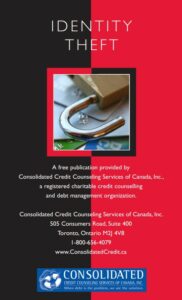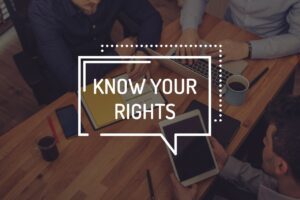
Identity Theft
This publication discusses the fastest-growing federal crime in the country and provides steps one can take to minimize the chances of personal information being stolen and used by a thief. The first part of this brochure is organized into checklists you can use to put these ideas into practice. The second part of this brochure will give you steps to take if you are a victim.

Congratulations on taking this important step to a brighter financial future. Consolidated Credit Canada has been helping Canadians across the country solve their credit and debt problems for years.
Our Educational Team has created over twenty-five publications to help you improve your personal finances. By logging onto www.consolidatedcreditcanada.ca you can access all of our publications free of charge. We have tools to help you become debt-free, use your money wisely, plan for the future, and build wealth. The topics Consolidated Credit Canada addresses range from identity theft to building a better credit rating; from how to buy a home to paying for university. On our website, you will also find interactive tools that allow you to calculate your debt and see how much it is costing you.
We are dedicated to personal financial literacy and providing a debt-free life for Canadians. If you are overburdened by high-interest rate credit card debt, then I invite you to speak with one of our trained counsellors free of charge by calling (844)-402-3073 for free professional advice.
Sincerely,
Jeffrey Schwartz
Executive Director
Consolidated Credit Canada.
Identity Theft
Some Facts About Identity Theft
Unfortunately, identity theft is a growing problem in Canada. The internet is an amazing tool but can also serve as a highway for your information to travel into the wrong hands. The PhoneBusters National Call Centre received 17,009 identity theft complaints by Canadians in 2012. Those victims reported a total loss of more than $15.9 million. In 2011, there were 17,006 complaints filed with PhoneBusters with reported total losses of more than $13.2 million. As you can see, this problem is not going away.
Luckily, most credit companies have action plans when faced with identity theft but you need to make sure you are doing your part as well.
Equifax and Trans Union of Canada indicate that they receive approximately 1400 to 1800 Canadian identity theft complaints each month. The majority of those complaints are from the province of Ontario. In addition to your creditors, your credit reporting agencies are on your side when it comes to identity theft. The important factor in this equation is communication. The following information is designed to assist you, as the consumer, in preventing and resolving identity theft.
(source: www.publicsafety.gc.ca)
Please visit www.publicsafety.gc.ca for more information on Identity Theft under the law enforcement policy section.
How Can You Help Protect Yourself From Identity Theft?
Unfortunately, there is no surefire way to protect yourself from identity theft. But there are steps you can take to minimize the chances that your information will be stolen and used by a thief.
The first part of this publication is organized into checklists you can use to put these ideas into practice. The second part of this booklet will give you steps to take if you are a victim.
Keep It To Yourself!
The less information that’s out there, the better!
• Carry only the cards you need in your wallet. It’s a good idea to leave extra credit cards and your Social Insurance card locked up safely at home.
• Make a copy of all your credit cards, front and back, and keep that list in a safe (locked) place in case your wallet or purse is stolen.
• When shopping, take your credit card receipts with you and then store them in a safe place at home. Pay attention while your purchases are being rung up to make sure the card information isn’t written down or copied an extra time.
• Don’t let a store clerk write your credit card number or any unnecessary identification information on your cheque. If she wants to write down your driver’s license number, for example, ask her not to write down the complete number. Ask to speak to a manager if the clerk insists on copying all your information onto your cheque.
• Don’t print your driver’s license or social insurance number on your cheques.
• When asked for your social insurance number, always ask if you can provide another number.
• Don’t use ABM machines from financial institutions you don’t recognize. Thieves have used ABMs to gather information from customers about their cards or accounts.
At Work:
Don’t let an ID thief catch you sleeping on the job
• Keep your purse locked up at work. Workplace theft is more rampant than most people realize. Ask your employer for a safe place to lock your purse or wallet if none is provided.
• Ask your employer about its security procedures for personnel files. Make sure they are locked and that there is a policy in place to protect theft. Many cases of identity theft have originated at work, and involved coworkers stealing personal data.
• Don’t log onto personal financial accounts from work and don’t set work computers to remember personal passwords automatically. Finally, don’t store personal information in your desk or in work computers.
At Home: Make sure your home is a safe haven
• Thieves can pluck bills or other mail from your mailbox and use that information to commit fraud. To protect yourself, use a locked mailbox if possible to receive mail. (Type “locked mailbox” in an Internet search engine for sources.)
• Never have new cheques sent to your home, unless your mailbox is secure. Ask them to be delivered to your bank and pick them up instead.
• Buy an inexpensive shredder to shred any mail or documents with sensitive information.
• Check your credit report at least once a year. Consider a credit monitoring service if you want to keep close tabs on your credit report. Early detection of fraud can save hours of time and hassle
later.
• Keep your personal information in a locked room or filing cabinet at home. This is especially important if you have frequent visitors (including your children’s teenage friends), a housekeeper, or others who may be in your home.
Get Off the List:
Protect your information and save a few trees
1. The Canadian Marketing Association offers the option of the Do Not Contact Service free of charge. Go to www.the-cma.org for further information.
2. On July 3, 2007, the Canadian Radio-Television and Communications Commission set out rules to create a National Do Not Call List. You can register your phone number(s) at www.dncl.gc.ca.
3. Consider an unlisted phone number, or at least ask the phone company to list your name in the phone book with only an initial and no address.
4. Opt-out of letting companies share your information. You should get annual privacy notices from financial institutions you do
business with. Take a minute to read them and say no if you don’t want them to share your information. There will be instructions for “opting out.”
Safer Surfing: If you’re not careful, your computer can be like an unlocked door into your home
• Use a firewall on your home computer. These are often inexpensive, and well worth it. If you are connected all the time to the Internet via a cable modem or DSL, it’s especially important to be protected.
• Choose good passwords. Don’t use your social insurance number, address, dates of you or your children’s birth, etc. The best passwords use letters and numbers, but don’t be obvious (your child’s name and date of birth, for example).
• Watch user names, too. Don’t use email addresses or user names that give away valuable personal information. For example, a user name of Hannah1199 might indicate you have a daughter named Hannah born in November 1999. Do you really want strangers to know that?
• Beware of “phishing.” With this scam, companies use email or fake websites to collect personal information from consumers. Thousands of consumers have fallen victim to the “PayPal” and “BestBuy” email scams, for example, where they allegedly received emails from these companies, asking them to log in and update their information. The sites were operated by fraudsters but looked real. Always log into financial sites from the home page you usually use and check out suspicious emails at sites devoted to exposing email hoaxes, such as www.antifraudcentre.ca or www.truthorfiction.org before responding to emails like this.
• Think twice before providing sensitive personal information online. In some scams, consumers have been duped into “applying for loans” on fake websites designed only to gather consumer information. In other cases, companies have sold information gathered from consumers, without their permission, to outside companies. Make sure the website is reputable before you type in your social insurance number or other identifying information.
• Free isn’t always good. Another recent scam involves sites offering “free” credit reports, which instead harvest information that can be used for identity theft. Visit the Financial Consumer Agency of Canada website for resources and links to fraud information nationwide at www.fcac.gc.ca in the Consumers
Section under Consumer Alerts.
• Shop carefully. Deal with merchants that have secure websites, and are reputable. For maximum protection, always use a credit card rather than Interac card when dealing with a new merchant online.
• Teach your children about online privacy and make sure they understand they are not to give out any personal information without your permission first.
• Before you trash a computer, make sure your information is no longer available to someone who may pick it up from the trash or a charity. Purchase a program that “wipes” your computer clean or physically destroys the hard drive. (Simply deleting files will not be sufficient.)
What to Do If It Happens to You If you have been a victim of identity theft, you’ll want to take these steps immediately:
• File a police report. You’ll need this to report the theft. Keep the original and make copies for others who need it.
• Notify the credit bureaus. Report the fraud immediately to the two major credit reporting agencies- Equifax and TransUnion. One company should notify the other but be sure to ask. Ask that a “fraud alert” be placed on your file.
• Contact your bank or credit card company if you have had your credit card or cheques stolen or wrongfully obtained.
• Contact PhoneBusters National Call Centre by phone or email. Go to www.phonebusters.com or call 1-888-495-8501. This is a government organization designed to track, investigate and help victims of fraud.
• Investigate new accounts. Review your credit report, preferably from both major bureaus, and contact all unknown creditors listed under New Accounts or Inquiries. Explain that you are an ID Theft victim and ask them how you can file a report. They’ll likely want proof of your identity, and a copy of the police report.
• Check your address. Check with Canada Post to see if a change of address has been filed. Also notify them if you suspect the imposter has used the Canadian Mail in their crime (for example, if they have mailed change of address notices or credit applications).
• Check your cheques. One unsuspecting consumer bought magazines from a young door-to-door salesman. Within hours, a fraud ring had made up fake cheques and was going on a spending spree with his account. If you suspect that your cheques are being used fraudulently contact the major credit
verification bureaus to file a fraud alert.
• Check your passport. Alert Passport Canada to make sure no one orders a passport with your information (either a replacement or a new one). You can visit their website at www.ppt.gc.ca or contact by phone at 1-800-567-6868.
What if you know the thief?
Many times consumers know the thief that stole their information. It may be a coworker, friend or even a relative or loved one. This can create additional problems since the victim is afraid of getting the thief in trouble with the law. Identity theft is a serious crime, however, and if you do not handle the situation appropriately you may be stuck with the after-effects for years to come. For helpful guidelines describing what to do when you know the criminal, visit the www.PhoneBusters.com website.
Identity Theft Fraud Alerts
If you think you may have been, or are about to be, a victim of identity theft, credit reporting agencies may place a fraud alert on your credit report if you request it. Keep in mind that this may result in a creditor asking you more questions the next time you apply for credit. The bank you are applying with wants to make sure your security is not sacrificed by double-checking that you are who you say you are.
Be sure to call both credit reporting agencies so that your fraud statement appears on each one. You will find the contact information for TransUnion and Equifax below.
About Consolidated Credit Canada
Consolidated Credit Canada is a consumer-oriented, non-profit organization. We are an industry leader in providing credit counselling and debt management services. Our mission is to assist individuals and families in ending financial crises and to help them solve money management problems through education, motivation, and professional counselling. Our organization is funded primarily through voluntary contributions from participating creditors. Our programs are designed to save our clients money and liquidate debts at an excellent rate.
We are dedicated to empowering consumers through educational programs that will influence them to refrain from overspending and abusing credit cards, as well as to encourage them to save and invest. Regardless of whether your financial problems are due to the purchase of a new home, the birth of a child, major illness, or any other circumstance, we can help.
* If you are headed for a debt disaster visit www.ConsolidatedCreditCanada.ca or call (844)-402-3073 for free professional advice by a trained counsellor.




